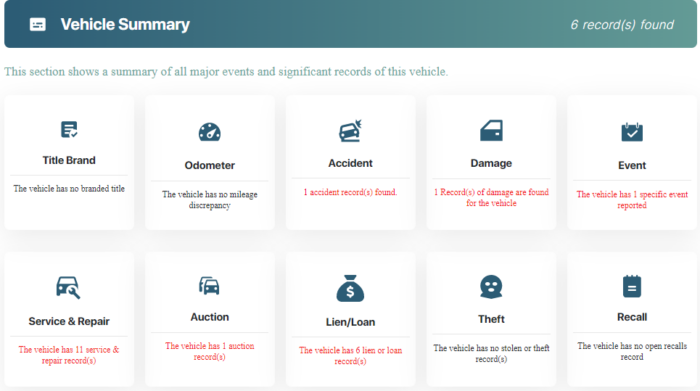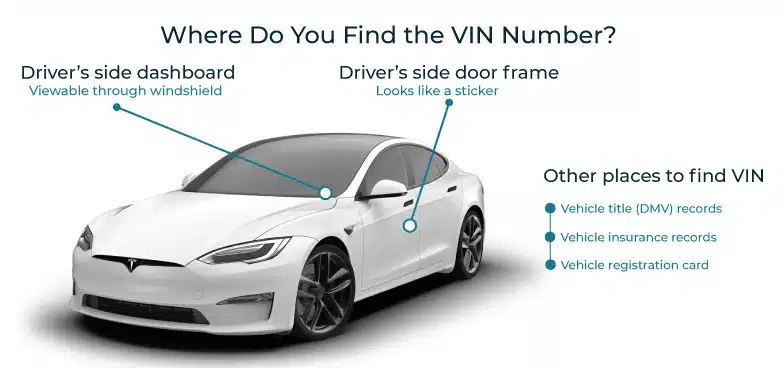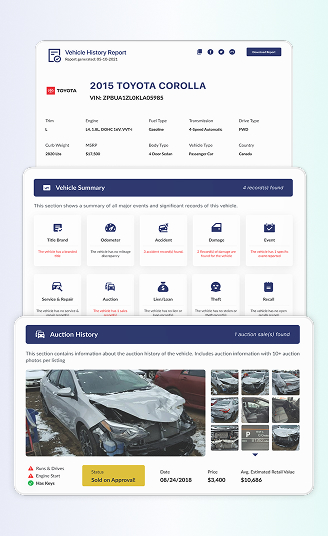Check Real Car Mileage & Odometer Rollback by VIN
Over 2 million vehicles had their odometers rolled back in 2024, an 18% increase from 2021. Odometer readings play a key role in determining a car’s condition, performance, and value. Higher mileage means more wear and tear, while lower mileage often signals less use and a better overall condition. Use our odometer check tool to easily verify a car’s true mileage and spot any discrepancies.
Understanding the Odometer
An odometer is a device used to indicate the distance a vehicle has travelled. The odometer is usually found on the dashboard on the driver’s side of the vehicle beside the speedometer. When buying a used car, the odometer reading indicates how often the vehicle was driven.
For example, cars with higher mileage often need more maintenance or replacement parts. Modern cars come with digital odometers, while older models use mechanical ones. Both types work differently but serve the same purpose: to track distance.
Mechanical Odometers, Digital Odometers, and Odometer Fraud
An odometer is a display that shows the mileage of the vehicle. Two different odometers are usually installed by the manufacturer: a mechanical odometer and a digital odometer.
Here’s a short explanation of how each odometer worked
Digital Odometer
The digital odometer is usually found in a newer variant of the vehicle, and it displays the mileage on the screen. The digital odometer is usually harder to tamper with, unless the criminal is smart enough to use specialised software.
Mechanical Odometer
The mechanical odometer uses a series of gears and numbers that turn as the wheels move. The numbers roll forward to record the total miles. Because of their design, it’s sometimes possible for dishonest sellers to roll the numbers backwards, which is known as odometer rollback.
Odometer Fraud
The odometer rollback happened when the mileage was changed to make a vehicle appear less used. This manipulation is often done by someone who wants to sell their vehicle to hide real wear, delay needed repairs, and lead buyers to overpay. Before you purchase a used vehicle, make sure you run an odometer check.
Odometer vs. Mileage
The odometer is the device that measures how far a car has travelled, while mileage is the number shown on the odometer that indicates the distance the vehicle has travelled.
Why Is the Mileage Check Important?
Mileage plays a big role in showing how much the car has been driven, to make sure that it receives the care it needs, and to examine the car’s usage. Checking the vehicle’s mileage is crucial for these reasons:
Shows the Car Real Usage: The mileage tells how far the car has been driven, not just by checking how old it is by the year. This section helps you check the car’s wear and tear.
Helps with Plan Maintenance:The Driver can use the mileage to plan the next maintenance according to the mechanic’s suggestion from the previous repair.
Prevents Overpaying:Lower mileage usually has a higher price, but if the odometer has been rolled back, buyers can end up paying too much for a worn-out vehicle.
Check the Fuel Efficiency:Older cars with higher mileage may not run as smoothly and will obviously need more fuel to be driven.
Set the Right Insurance Cost: The insurance companies will usually charge more to insure a vehicle that has high mileage. A vehicle with high mileage may get higher rates because it's more likely to have mechanical problems to involved in accidents.
Real Example: Why You Need a Mileage Check?
An odometer discrepancy is a trick used by sellers to lower the mileage. This practice is usually done to make the vehicle less used to increase the selling price.
Here’s an example of it.
The odometer discrepancy was found in a vehicle report for a 2013 Nissan Altima (VIN: 1N4AL3AP7DC234493). Below is the recorded table for the car’s mileage.
The report shows a stagnation in mileage from 57,711 within two months. This unusual change suggests a possible odometer rollback or alteration, which raises doubts about the vehicle’s true mileage. Such inconsistencies can affect the car’s value and reliability, making it essential to perform a detailed inspection and verify its history before buying.

Date Recorded
- 07/30/2013
- 11/09/2015
- 09/26/2016
- 12/09/2016
- 02/13/2017
Mileage Recorded
- 165
- 43,055
- 55,711
- 57,711
- 57,711
How to Check Real Car Mileage?
To check car mileage, compare the odometer reading with service records, review a vehicle history report using the VIN, look for wear that doesn’t match the displayed miles, and use an OBD2 scanner to confirm data from the car’s computer.
Detailed Vehicle History Report
Through our vehicle history report, you can check the car’s mileage accurately because it is written along with the date and the last recorded mileage of the vehicle.
A mileage check report gives more than just the car’s odometer reading. It provides a full view of the vehicle’s background to help buyers make safe and informed choices. Here’s what it includes:
- Odometer Rollback: Shows if the car’s mileage has ever been changed or reduced by sellers or dealers.
- Ownership History: Lists how many people have owned the car and when ownership changed.
- Accident Records: Reveals if the vehicle has been involved in any reported crashes or damage events.
- Auction and Sales History: Displays if the car was ever sold at auction and tracks its sales timeline. You can also use the MSRP by VIN to compare its original price with its current value.
- Lien and Loan Information: Checks if the vehicle has any active loans or unpaid liens that could cause financial issues later.
- Service and Repair Records: Tracks past maintenance, repairs, and warranty status to help plan future servicing.
The report also includes odometer data and flags any special cases, such as exempt mileage titles, where the reading might not appear as expected.
Use a Computer Diagnosis
A computer diagnostic can read the mileage stored in the car’s ECU (Engine Control Unit). The number should be close to what’s shown on the dashboard, even though they may not always match exactly. Small changes, like installing bigger wheels, can also affect how mileage is recorded.
While the diagnostic gives helpful insight, it’s not always perfect. For a full picture of the car’s setup, including transmission type, drivetrain, paint code, interior details, and factory options, checking the vehicle’s build sheet is also recommended.
Physical Inspection of the Car
A careful physical inspection can also help detect odometer tampering. Start by checking the odometer itself for any signs of manipulation, such as uneven or misaligned numbers. Then, compare the car’s overall wear with the mileage displayed.
Look for these details:
- Windshield: Check for scratches or small chips that suggest frequent driving.
- Pedals: Worn-out brake or clutch pedals may indicate higher mileage.
- Steering wheel: Look for cracks, fading, or rough surfaces that show heavy use.
- Driver’s seat: Sagging cushions or torn fabric can point to long use.
- Exhaust system: Make sure it’s working properly and doesn’t show heavy corrosion or soot buildup.
By matching the physical condition of these parts with the reported mileage, buyers can spot signs of odometer rollback or hidden wear.
Impact of Odometer Fraud in the U.S.
A report released in December 2024 found that more than 2.14 million cars in the U.S. had their odometers rolled back. This marks an 18% rise in odometer fraud compared to 2021, and about 82,000 more cases than in 2023.
Financial Impact of Odometer Rollbacks
Odometer fraud causes serious financial damage to car buyers.
- Average loss: Around $4,000 is lost per car with a rolled-back odometer.
- Total annual cost: Estimated at over $1 billion in the U.S.
- Hidden expenses: These losses don’t include extra repair bills or safety issues that may come from driving cars with false mileage.
Top States for Odometer Fraud in 2024
Nine out of the ten states below saw an increase in odometer tampering cases in 2024:
- California: 484,500 vehicles (+3.3%)
- Texas: 294,200 vehicles (+6.2%)
- New York: 97,400 vehicles (−2.8%)
- Florida: 90,900 vehicles (+6.4%)
- Illinois: 79,200 vehicles (+0.2%)
- Georgia: 70,400 vehicles (+1.1%)
- Pennsylvania: 70,300 vehicles (+3.9%)
- Virginia: 63,400 vehicles (+11.7%)
- Arizona: 60,200 vehicles (+8.0%)
- North Carolina: 51,000 vehicles (+3.6%)
How to Protect Against Odometer Fraud
Odometer fraud happens when someone changes or hides a vehicle’s true mileage to make it look newer or more valuable. To stay safe when buying a used car, take these simple steps:
- Check the Vehicle History: A VIN-based report can show past mileage records from services, inspections, and registrations. Any sudden drop or mismatch in numbers could mean tampering.
- Inspect the Condition: Look at wear on the pedals, seats, steering wheel, and tires. If the car looks older than the mileage suggests, it might have been rolled back.
- Ask for Maintenance: Review service receipts and inspection reports to see if mileage readings increase steadily over time.
- Get a Professional’s Help: A trusted mechanic can use diagnostic tools to read data from the car’s electronic systems and confirm the real mileage.
- Avoid a Vehicle That Seems Too Good to be True: If the vehicle has lower mileage but also has a very low price, don’t buy it because it can be a sign of a tampered odometer.
The most common reason is profit. Lower mileage makes a used car look newer and more reliable, allowing the seller to demand a higher price. Even rolling back 20,000 to 40,000 miles can increase the car’s resale value by thousands of dollars.
Detailed Vehicle History vs. Carfax Odometer Check?
| Feature | CarFax | Detailed Vehicle History |
|---|---|---|
| Accuracy | Actual mileage reading is not guaranteed | Guarantee of full coverage of the odometer and mileage-driven |
| Odometer Inspection | No direct odometer reading or inspection | Directly reports the odometer reading and inspection |
| Mileage Discrepancy Detection | Only flags potential rolled odometer by mileage history | Explicitly notifies if a rolled-back odometer is detected |
| Methodology | Analyzed historically recorded mileage | Uses the window sticker lookup to get the data, including the odometer report. |
| Scope of Report | Focus on detecting odometer tampering | Provides detailed insights into the actual mileage and MSRP by VIN. |
Mileage Check FAQs
Is odometer rollback a felony?
Yes, odometer rollback is a serious criminal offence that is illegal under federal law and state law. If one commits with a rolled back odometer, it can result in penalties like prison time, penalties, civil penalties for damage, and legal costs.
Is it possible to roll back a digital odometer?
Yes, both manual and digital are possible to be rolled back. With basic plug-in devices, fraudsters can quickly edit the numbers shown on the display. Because modern cars keep mileage data in different electronic modules, specialised tools are often used to adjust every system.
How to find the odometer history?
You can check a vehicle’s odometer history by running a vehicle history report with its VIN, reviewing maintenance records, and using an OBD scanner to read data from the car’s computer.
How can I tell if the odometer has been rolled back?
To spot odometer rollback, compare the current mileage with older records from service reports, registration papers, and VIN-based vehicle history reports. Look for any gaps or sudden drops in mileage. Also, check for signs of wear inside the car, like worn pedals, seats, or steering wheels, that don’t match a low odometer reading. Finally, inspect the odometer closely for misaligned numbers or physical signs of tampering.
Examine Documentation
- Vehicle History Reports: Get a detailed report using the VIN from services such as Carfax or similar platforms. These reports often show mileage differences between past maintenance or inspection records.
- Maintenance Records: Review oil change stickers, service invoices, and logbooks to confirm mileage increased consistently over time.
- Title History: Check the car’s title for any previous mileage entries. Old titles sometimes show readings that help uncover inconsistencies.
Inspect the Vehicle for Inconsistencies
- Wear and Tear: A car claiming low mileage shouldn’t have heavy wear on high-contact areas like the pedals, seats, or steering wheel.
- Pedals: Smooth, shiny, or heavily worn pedals can suggest the car has been driven much more than the odometer shows.
- Tires and Brakes: Look at tire age and condition using the DOT code, and inspect brake wear. Tires typically last between 30,000 and 80,000 miles, which can help estimate real usage.
- Scratches and Gaps: Examine the odometer for loose screws, scratches, or uneven gaps between digit signs often linked to tampering in older mechanical models.
Consider a Professional Inspection
- Mechanic’s Inspection: Have a trusted mechanic inspect the vehicle’s condition. They can spot wear that doesn’t match the displayed mileage.
- Digital Odometers: For newer vehicles, digital odometers may require special diagnostic tools. Mechanics can check the car’s ECU (engine control unit) to verify the real mileage stored in the system.
What is good mileage for a used car?
Good mileage for a used car often depends on its age. A common rule is that a car usually covers about 12,000 to 15,000 miles per year. So, a five-year-old car with around 60,000 to 75,000 miles is generally considered reasonable.
Mileage Guidelines by Age
- Under 60,000 miles: This is usually seen as low mileage. Cars in this range are often newer, with less wear and plenty of life remaining.
- 60,000 to 100,000 miles: This is a normal range for most used vehicles. Depreciation has already levelled off, and many modern cars can easily exceed 100,000 miles with regular maintenance.
- Over 100,000 miles: High mileage doesn’t always mean poor condition. If the car has been well serviced, it can still offer reliable performance and good value, especially since the price is often much lower than newer options.
Can you check the mileage by VIN number?
Yes, it’s possible to check a vehicle’s mileage using its VIN. A VIN-based report from Detailed Vehicle History can show the car’s recorded mileage at different times, gathered from service centres, inspections, and ownership records. This helps reveal any sudden drops or mismatched readings that could point to odometer rollback.
How to Check the Mileage
- Locate the VIN: Find the 17-digit Vehicle Identification Number, usually on the dashboard near the windshield or on the driver’s side door frame.
- Request a Vehicle History Report: Use the VIN on Detailed Vehicle History to get a complete report that includes past mileage readings, title updates, and other useful records.
- Use the VIN Check Tool: The mileage check tool on Detailed Vehicle History can display key information about the vehicle’s history, including reported mileage data.
- Compare Records: If you have service receipts or inspection notes, compare their mileage figures with the readings shown in the Detailed Vehicle History report and on the car’s odometer to ensure consistency.
Where is the car mileage located?
The car’s mileage can be found on the odometer, located on the vehicle’s dashboard near the speedometer. It shows how far the car has been driven. In older vehicles, it appears as a set of turning numbers, while in newer ones, it’s shown on a digital display.
Where to Look
- On the dashboard: The odometer is usually part of the instrument cluster, right in front of the driver. It’s often placed beside or inside the speedometer for easy viewing.
- Using the trip meter: Many cars include a trip meter or trip odometer, which can be reset to track short distances. You may need to press a button on the dashboard or steering wheel to switch between the total mileage and the trip reading.
How to Read It
- Mechanical (analogue): Check the row of numbers. The last digit often shows tenths of a mile.
- Digital: Read the numbers on the screen. The rightmost digit may also represent tenths of a mile or a kilometre, depending on the vehicle’s settings.
How to Read Car Mileage?
To read the mileage on a car, look at the odometer, which is usually located on the dashboard near the speedometer. The numbers on the screen or dial show how far the car has travelled since it was first built.
For digital odometers
- Turn the ignition key to the “on” position without starting the engine.
- Look at the digital display, which is typically found on the instrument panel behind the steering wheel.
- Read the numbers shown; the last digit often represents tenths of a mile.
- If multiple readings appear, use the dashboard buttons or steering wheel controls to switch between total mileage, trip mileage, and other display options.


